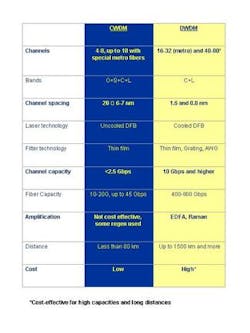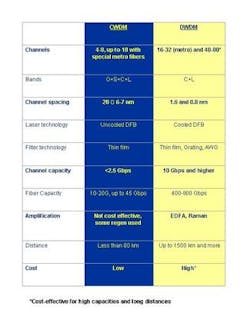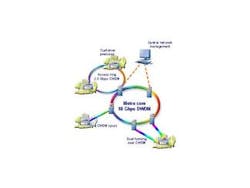CWDM or DWDM in metro networks: Which platform makes economic sense?
By Michael Schneider, ECI Telecom--Today, fiber exhaust is still a common problem in many metro networks. Although, the price of fiber-optic cable continues to drop, the trenching, labor, and other installation costs remain very high. WDM technology was developed to get more capacity from the existing fiber-optic cable plant, by using channels (wavelengths) to carry multiple signals on a single fiber.
The WDM technology developed for use in metro networks comes in two flavors: coarse WDM (CWDM) and dense WDM (DWDM). A major difference between the two, as their names imply, is the channel spacing within the window of the optical spectrum. The wide pass-band (20 ± 6-7 nm) of CWDM channels allows for the use of less expensive components such as uncooled lasers and thin-film filter technology. CWDM systems provide cost advantages over DWDM in the same application. As such, many people tout CWDM as a more appropriate platform for the shorter distances typically found in metro access networks.
Sometimes metro networks require longer distances and more wavelengths than CWDM can provide, however. Today CWDM does not practically support more than the 18 channels between 1271 and 1611 nm, standardized by the ITU-T G.694.2 wavelength grid. In addition, 10-Gbit/sec wavelengths are not readily available on carrier-class systems. Relatively low cost "metro" DWDM can pack many 2.5- and 10-Gbit/sec wavelengths--up to 40--onto a single fiber. However, in order to do so, precision filters, cooled lasers, and more real estate are needed, which can make DWDM too expensive for some edge networks.
What is the best solution? Depending on cost, distance, and the number of channels, metro area networks may benefit from a mixture of both coarse and dense WDM technologies.
Early deployments
Early WDM deployments in the mid 1980s emerged in the form of "doublers," which used 1310-nm and 1550-nm lasers through passive filters to transport two signals on a single fiber. This straightforward approach was reliable, low-cost, and easy to operate, which made it suitable for carrier networks.
Other WDM techniques were tailored for specific applications. CWDM was used mostly in LANs due to the reach limitations imposed by operating in the 850-nm range. By the early 1990s, WDM development was focused on solving capacity shortages experienced by inter-exchange carriers. Their national backbone networks presented a different set of parameters and cost structure. This enabled the use of more complex and expensive components, which made high capacity transport over long distances possible. DWDM with its narrow channel spacing (1.6 and 0.8 nm) allowed many wavelengths in a small window of optical spectrum. Narrow channel spacing is important for long distances because fiber attenuation is lowest in the rather slim C-band.
DWDM in the metro core
As metro-area bandwidth requirements grew, long-haul DWDM vendors saw an opportunity to apply the same solution in metro networks. A different set of requirements was involved, however. Distances were much shorter. Fiber plant was more available and typically installed in rings for SONET transport. Protocol transparency became more important in order to handle a greater variety of services, such as Gigabit Ethernet, storage protocols, and video found in the metro.
Carriers were looking for a cheaper and simpler version of long-haul DWDM. These factors led equipment makers to adapt DWDM systems accordingly. Banded wavelength filters, elimination of dispersion compensation, and more tolerant channel spacing were seen as ways to accomplish this goal. Today, metro DWDM is a good fit for high-capacity core networks in the metro and for regional extensions between metro areas.
CWDM in the metro access
The current economic climate and recent ITU-T Recommendation G.695 standardization of optical interfaces for CWDM have sparked a greater interest in the platform for metro networks. Early CWDM was proprietary and geared mostly towards enterprise applications. Today CWDM, offered by mainstream transport vendors, is carrier-class and commonly supports at least eight of the eighteen ITU-T G.694.2 defined channels over distances of up to 80 km. CWDM networks are simple point-to-point and ring topologies that do not use expensive erbium doped-fiber amplifiers typically associated with DWDM. A comparison of the major differences between CWDM and DWDM is shown in the table.
CWDM's lower cost and small footprint fit well with customer premises and co-location installations. Gigabit interface converters and small form factor pluggable (SFP) transceivers for the platform are readily available because they are less complex. The use of pluggable optics also enables wavelength selectivity at the time of deployment and direct connections to the data communications equipment generating the traffic flows. This ease of use is a big reason for CWDM's popularity in enterprise and storage networks.
Multiservice provisioning platform (MSPP) vendors have begun to include CWDM optics on their SONET interfaces. CWDM lasers on SONET platforms will allow carriers to take advantage of CWDM without requiring the use of expensive transponder-based systems. Some carriers believe this step is crucial for widespread acceptance of the technology.
Transponders can be used to connect many traffic types to the same CWDM system. These modules also provide a demarcation point for service providers. Pluggable optics are used in some transponders to increase their flexibility, while the use of tunable modules can reduce sparing requirements. Combiners can combine or multiplex several lower-rate signals, such as GbE or OC-12, onto a single high-rate wavelength transponder, extending the service life of CWDM by using wavelengths more efficiently.
CWDM is most suitable for networks with the following characteristics:
• Low channel count of 4 to 8 channels,
• Transmission rates of <2.5 Gbits/sec per channel, and
• Short distances of <80 km.
Cost comparisons
Channel count, throughput rates, and distances can overlap in CWDM and DWDM platforms. Cost, however, is still a key difference between these two systems. Based on raw component prices, estimates regarding the expected savings of a CWDM platform range as high as 50%.
It may be more germane to compare the cost of the systems, however. This comparison takes into account component cost and system production and to some degree, the market-adjusted selling price. A simple and plausible configuration for the comparison is a point-to-point link between two sites that are about 25 mi (40 km) apart. All eight channels are carrying 2.5-Gbit/sec (OC-48) traffic using 3R transponders with no protection. This amount of traffic is at the high end for CWDM. Therefore, DWDM may be initially assumed the better choice.
In this scenario, the cost of the CWDM system is almost a third less than that of the DWDM system While the cost of the multiplexer/demultiplexer is 46% less for the 8-channel CWDM system, 66% of the cost savings is from the transponders, which represent the most expensive part of WDM systems with a considerable number of channels. Of course, there will be operational savings of power and cooling too. On the other hand, the 30% premium may be a worthwhile investment if growth to 16 or more channels is likely.
A metro access application would have fewer wavelengths, for example, a CWDM system with four channels. The overall savings now relative to DWDM, are a bit better--close to 37%. This is mostly due to the low-end scalability of CWDM, and the fact that the multiplexer/demultiplexer used in the system is sized for the four-channel application. The trend continues with a more proportional reduction in component categories as the number of channels is reduced. Based on equipment cost, the case can be made for CWDM as a more profitable solution for edge applications such as enterprise LAN extensions, storage networks, and video on demand distribution.
Room for both
Since both technologies are viable in the metro, compatibility and interoperation are topics of interest, and several methods of integration have been proposed.
An overlap in the bands used by both systems can allow the narrow spectrum of DWDM to "ride" over a few channels of CWDM in the C-band region. This approach would enable a low entry cost without sacrificing channel count or the 2.5-Gbit/sec rate limitation of coarse-wave.
However, this may not be an everyday scenario because the incremental cost of adding that first "extra wavelength" is huge. CWDM is more suitable in the metro access portions of the network where cost is more important than capacity.
Another aspect of interworking is what happens at hub sites where metro-access CWDM and metro-core DWDM meet. This is where traffic from the edge must migrate onto core rings for transport throughout the network. In the worst-case scenario, two separate back-to-back systems are used to de-multiplex and re-multiplex traffic from one platform to the other. The downside here, obviously, is two sets of equipment, including transponders.
Some vendors offering both CWDM and DWDM technologies have merged the system building blocks onto a single platform. This approach allows the de-multiplexed CWDM traffic to be directly connected to DWDM transponders, saving equipment and space. It also enables end-to-end performance monitoring and cost optimization throughout the entire metro network.
Pluggable optics such as SFP transceivers that support CWDM optical interfaces are readily available. These modules enable switches, routers and even some SONET MSPPs to deliver the right wavelength frequency directly to the optical multiplexer. The same pluggable technology is now being applied to DWDM interfaces. Product announcements for SFP versions were made as early as January 2004 promising CWDM price points. Although these SFP lasers are not tunable, this is an important development to watch.
Carriers should not have to choose between CWDM and DWDM. The better choice is a converged solution that takes advantage of the economies of CWDM for shorter distances, and provides the power of a DWDM network where longer distances and more capacity are needed. The result is an integrated, economical network that doesn't require a carrier to compromise on quality, quantity, or cost. This paradigm may help CWDM technology gain traction in the carrier space.
Finally, optical networks are becoming more flexible While CWDM may fit an application's needs today, as the demand for broadband services grow, it might require DWDM, especially if service providers look beyond metro networks to regional and long haul networks for increased coverage.Michael Schneider is marketing manager for ECI Telecom (Vienna, VA).

